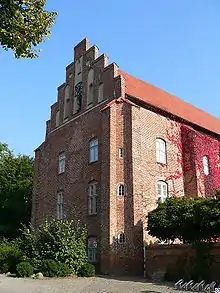
Cismar Abbey (German: Kloster Cismar) was a Benedictine monastery located at Cismar near Grömitz, Schleswig-Holstein, in Germany.
History
The abbey was founded in 1238 by Count Adolf IV of Holstein as alternative accommodation for Benedictine monks from Lübeck. In the mid-15th century it was one of the six original members of the influential Bursfelde Congregation, a Benedictine reform movement. After three prosperous centuries, based largely on its possession of a relic of the blood of Christ and a healing spring dedicated to John the Baptist, which made it a centre of pilgrimage, it was dissolved in 1561 during the secularisation brought about by the Reformation. The monastic library is preserved in the Danish Royal Library in Copenhagen.[1]
The Brick Gothic abbey church is famous for its carved altar, dating from the early 14th century, still in place in the church.[1][2]

The other surviving buildings, after a wide variety of secular uses, now serve as a museum.[2]
References
- 1 2 Grabowsky, Anna-Therese: Das Kloster Cismar, Karl Wachholtz Verlag Neumünster, 1982
- 1 2 Cismar.de: local information website, including Cismar Abbey
External links
54°11′24″N 10°59′09″E / 54.19000°N 10.98583°E